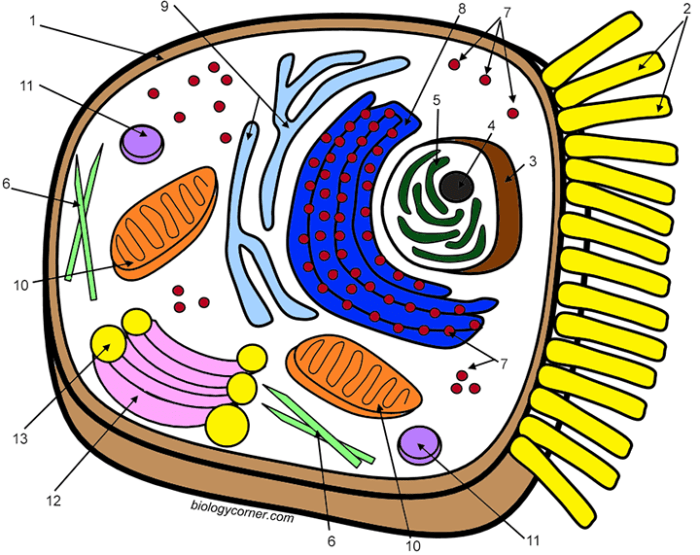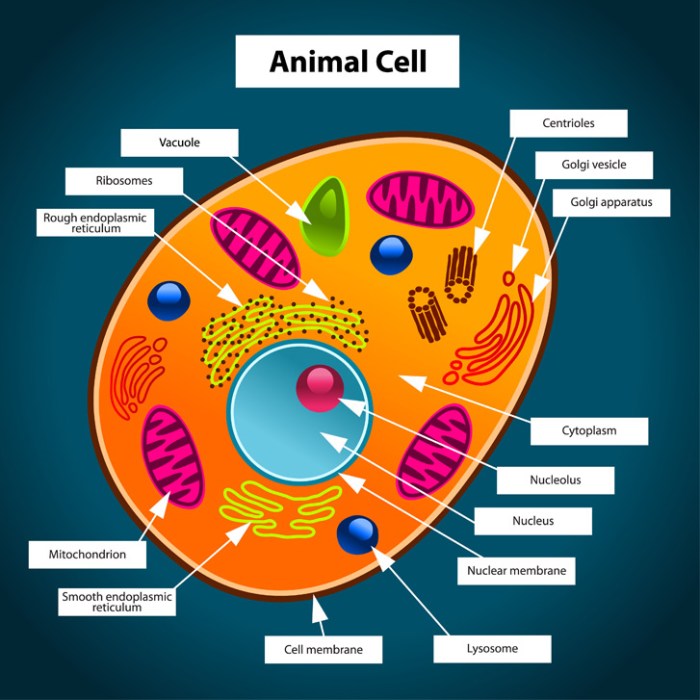Introduction to Animal Cells

Animal cells worksheet coloring – Welcome, young scientists! Let’s embark on a colorful journey into the fascinating world of animal cells! These tiny building blocks are the fundamental units of life for all animals, including you and me! We’ll explore their key features and compare them to their plant counterparts. Get ready to color your way to a deeper understanding of these amazing structures.Animal cells are eukaryotic cells, meaning they have a membrane-bound nucleus containing their genetic material (DNA).
They are characterized by their diverse shapes and sizes, adapting to the specific functions they perform within an organism. Unlike plant cells, they lack a rigid cell wall and chloroplasts, which are responsible for photosynthesis. This lack of a cell wall contributes to the flexibility and varied shapes found in animal cells.
While meticulously coloring your animal cells worksheet, one might find the intricate details surprisingly reminiscent of a polar bear’s fur. For a delightful change of pace, and perhaps a touch of seasonal cheer, consider supplementing your cellular studies with some charming illustrations from winter animals coloring pages free ; it’s a surprisingly effective way to de-stress after a rigorous session of identifying organelles.
Returning to those diligently colored cells, you’ll appreciate the beauty of both the microscopic and the majestic.
Animal Cell Organelles
The animal cell is a bustling city of miniature organelles, each with a specific job to keep the cell running smoothly. Understanding these components is key to understanding the cell’s overall function.
The nucleus, the cell’s control center, houses the DNA and directs cellular activities. Imagine it as the city hall, managing all the operations. Surrounding the nucleus is the cytoplasm, a jelly-like substance filling the cell and providing a medium for chemical reactions. This is like the city’s infrastructure, allowing movement and communication between different parts. The mitochondria are the powerhouses, generating energy for the cell through cellular respiration.
Think of them as the power plants, providing the energy for the city’s functions. The endoplasmic reticulum (ER) is a network of membranes involved in protein synthesis and lipid metabolism; it’s like the city’s transportation system, moving materials around. The Golgi apparatus processes and packages proteins for transport; it’s the city’s postal service, sorting and delivering packages. Ribosomes are the protein factories, synthesizing proteins according to the instructions from the DNA.
These are like the city’s factories, producing essential goods. Lysosomes are the recycling centers, breaking down waste materials. They are the city’s waste management system. Finally, the cell membrane encloses the entire cell, regulating what enters and exits; it’s the city’s border control, managing the flow of goods and people.
Differences Between Plant and Animal Cells
While both plant and animal cells are eukaryotic, several key differences set them apart. These differences reflect the distinct lifestyles and needs of plants and animals.
Plant cells possess a rigid cell wall made of cellulose, providing structural support and protection. Animal cells lack this cell wall, contributing to their flexibility. Plant cells contain chloroplasts, the sites of photosynthesis, allowing them to produce their own food. Animal cells lack chloroplasts and rely on consuming other organisms for energy. Finally, plant cells typically have a large, central vacuole for storing water and nutrients, whereas animal cells have smaller, less prominent vacuoles.
These differences are crucial to the distinct functions and characteristics of each cell type.
Worksheet Design & Structure: Animal Cells Worksheet Coloring
Designing an engaging and informative worksheet for coloring animal cells requires careful consideration of layout, organization, and visual appeal. The goal is to create a resource that is both fun and educational, reinforcing students’ understanding of cell structure and function. A well-designed worksheet will help students actively learn and remember the key components of an animal cell.The worksheet should be structured to facilitate clear understanding and easy navigation for students of all learning styles.
Visual cues, clear labeling, and a logical flow of information are crucial for effective learning. Furthermore, the design should be visually appealing to encourage engagement and prevent student fatigue.
Worksheet Layout and Organelle Representation
The worksheet will feature a large, central space for students to color a simplified representation of an animal cell. This central image will clearly depict four key organelles: the nucleus (large, centrally located, and labeled), the mitochondria (numerous, bean-shaped, and labeled), the endoplasmic reticulum (a network of interconnected tubes and sacs, partially visible and labeled), and the Golgi apparatus (a stack of flattened sacs, positioned near the nucleus and labeled).
Each organelle will be clearly delineated and appropriately sized relative to each other within the cell’s boundary. The cell membrane will be represented as a continuous line around the cell’s contents. Sufficient space around the cell will allow for comfortable coloring. The coloring area should be large enough to avoid overcrowding, but small enough to be manageable for young learners.
Design Considerations for Visual Appeal and Educational Effectiveness, Animal cells worksheet coloring
Coloring pages are inherently visually appealing, but thoughtful design choices enhance their educational value. The use of bright, non-distracting colors for the labels and cell membrane will improve readability. The organelles will be depicted in a simple, easily recognizable style, avoiding excessive detail that could confuse young learners. Clear, concise labels for each organelle will be positioned close to their corresponding structures to avoid ambiguity.
The font used for labels will be large and legible, ensuring easy readability for all students. The overall design will maintain a clean and uncluttered appearance to maximize visual clarity and avoid overwhelming the student. The background of the worksheet could be a simple, light color to provide contrast and prevent the image from being visually cluttered.
Coloring Activities & Extensions

Let’s make learning about animal cells fun and engaging! This section will guide you through creating a vibrant coloring activity and suggest ways to extend the learning beyond the worksheet. The goal is to solidify understanding of animal cell structures and their functions in a memorable and interactive way.This section details a coloring activity designed to reinforce the understanding of organelle placement and function within the animal cell.
It also provides fun facts to pique student interest and suggests extension activities to further enrich the learning experience.
A Coloring Activity to Reinforce Understanding of Organelle Placement and Function
The coloring activity will utilize a pre-designed worksheet featuring a simplified diagram of an animal cell. Each organelle will be clearly labeled, but not colored. Students will be provided with a color key that matches each organelle to a specific color. For example, the nucleus might be assigned purple, the mitochondria a vibrant orange, and the Golgi apparatus a light blue.
This activity helps students visualize the spatial relationships between organelles and associate colors with specific functions. The careful placement of colors reinforces their understanding of each organelle’s location within the cell. Students should also be encouraged to label each organelle after coloring it, further reinforcing their knowledge.
Five Fun Facts About Animal Cells
Learning about animal cells can be more engaging with interesting facts. Here are five fun facts that can be incorporated into the lesson:
- Animal cells are incredibly small! Millions could fit on the head of a pin.
- The mitochondria, often called the “powerhouses” of the cell, produce the energy the cell needs to function, similar to how a power plant generates electricity for a city.
- The cell membrane acts like a gatekeeper, controlling what enters and exits the cell, much like a border control for a country.
- Animal cells don’t have a cell wall, unlike plant cells, making them more flexible and able to move more easily.
- The Golgi apparatus processes and packages proteins, like a post office sorts and delivers mail.
Classroom Activities to Extend Learning
Beyond the coloring activity, several classroom extensions can enhance understanding and engagement. These activities provide opportunities for hands-on learning and collaborative exploration.
- Build a 3D Model: Students can create three-dimensional models of animal cells using readily available materials like clay, playdough, or even recycled materials. This allows for a more tactile and spatial understanding of the cell’s structure and the relative sizes of organelles.
- Microscopy Exploration: If available, using microscopes to view prepared slides of animal cells (such as cheek cells) provides a real-world connection to the concepts learned. Observing actual cells helps students visualize the structures they have been studying.
- Research and Presentation: Assign students specific organelles to research in more detail. They can then create presentations or posters to share their findings with the class, fostering collaboration and deeper understanding.
- Interactive Games: Incorporate online games or interactive simulations that focus on animal cell structures and functions. These digital tools can offer engaging and interactive learning experiences.
- Comparative Study: Compare and contrast animal cells with plant cells, highlighting the key differences and similarities between the two cell types. This activity promotes critical thinking and expands their understanding of cell biology.
